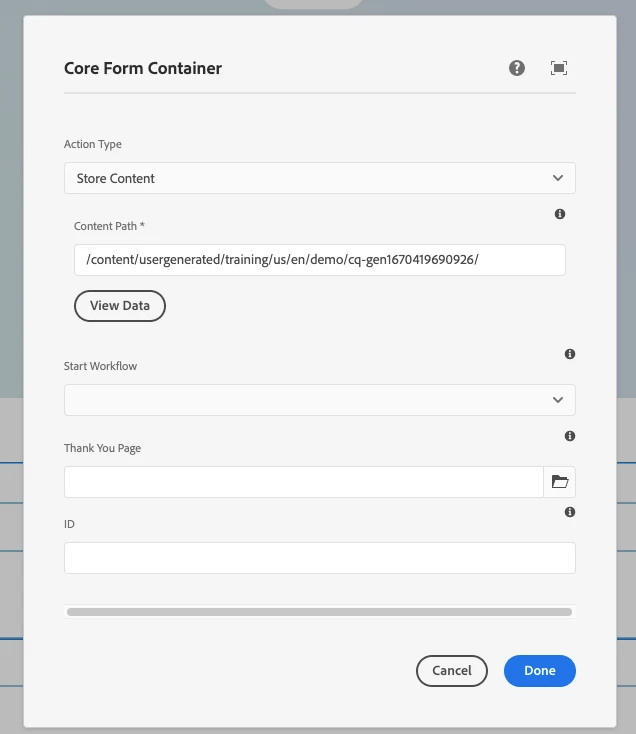Hi @df94 ,
You can implement custom logic to save form data in repository by implementing
- Sling Model
- Servlet
- OSGi Services
per your requirement.
Additionally, refer one of the following example code snipper for the same.
In AEM data is stored in JCR in the forms of nodes and properties, So to save data in JCR, you need to create nodes or/and properties. In your servlet get the data and create node/property using JCR Node.
Please check below snippet, it is just for demonstration.
- Create Component and add below code in HTL
HTL
<form id="submitForm" method="post" action="/apps/my/servlets/path/create">
<input type="text" name="name" value="" />
<input type="text" name="email" value="" />
<input type="text" name="title" value="" />
<input type="text" name="phone" value="" />
<input type="submit" value="Submit"/>
</form>
- Create Servlet which is responsible to handle form request and save data in JCR node.
Servlet
package com.test.servlet;
import com.day.cq.commons.jcr.JcrUtil;
import org.apache.felix.scr.annotations.Component;
import org.apache.felix.scr.annotations.Properties;
import org.apache.felix.scr.annotations.Property;
import org.apache.felix.scr.annotations.Reference;
import org.apache.felix.scr.annotations.sling.SlingServlet;
import org.apache.sling.api.SlingHttpServletRequest;
import org.apache.sling.api.SlingHttpServletResponse;
import org.apache.sling.api.servlets.SlingAllMethodsServlet;
import org.apache.sling.jcr.api.SlingRepository;
import org.osgi.service.component.ComponentContext;
import org.slf4j.Logger;
import org.slf4j.LoggerFactory;
import javax.jcr.Node;
import javax.jcr.RepositoryException;
import javax.jcr.Session;
import javax.servlet.ServletException;
import java.io.IOException;
import java.io.PrintWriter;
@Component(immediate = true, metatype = true, name = "com.test.CreateServlet", label = "Create Servlet", description = "Test creation servlet")
@SlingServlet(methods = { "POST" }, paths = "/apps/my/servlets/path/create", generateComponent = false)
@Properties({ @Property(name = "service.description", value = "CreateServlet"), @Property(name = "service.vendor", value = "My Vendor") })
@SuppressWarnings({ "serial", "unused" })
public class CreateServlet extends SlingAllMethodsServlet {
private static final String CREATE_PATH = "/content"; /// Set the base path here
private static final Logger log = LoggerFactory.getLogger(CreateServlet.class);
@Reference private SlingRepository repository;
@Override protected void doGet(SlingHttpServletRequest request, SlingHttpServletResponse response) throws ServletException, IOException {
//We are not using this atm.. but you could
}
@Override protected void doPost(SlingHttpServletRequest request, SlingHttpServletResponse response) throws ServletException, IOException {
ResourceResolver resourceResolver = request.getResourceResolver();
Session session = resourceResolver.adaptTo(Session.class);
String name = request.getParameter("name");
String email = request.getParameter("email");
String title = request.getParameter("title");
String phone = request.getParameter("phone");
PrintWriter out = response.getWriter();
try {
Node firstProduct = JcrUtil.createPath(CREATE_PATH + "/" + name , "cq:Page", session);
Node firstSubProduct = JcrUtil.createPath(firstProduct.getPath() + "/subproduct1", "nt:unstructured", session);
Node secondSubProduct = JcrUtil.createPath(firstProduct.getPath() + "/subproduct2", "nt:unstructured", session);
firstSubProduct.setProperty("email", email);
firstSubProduct.setProperty("title", title);
secondSubProduct.setProperty("email", email);
secondSubProduct.setProperty("title", title);
session.save();
out.println("That went well...");
out.flush();
out.close();
}
catch (RepositoryException e) {
out.println("That went not so well...");
out.flush();
out.close();
e.printStackTrace(); //To change body of catch statement use File | Settings | File Templates.
}
}
Hope that helps!
Regards,
Santosh


